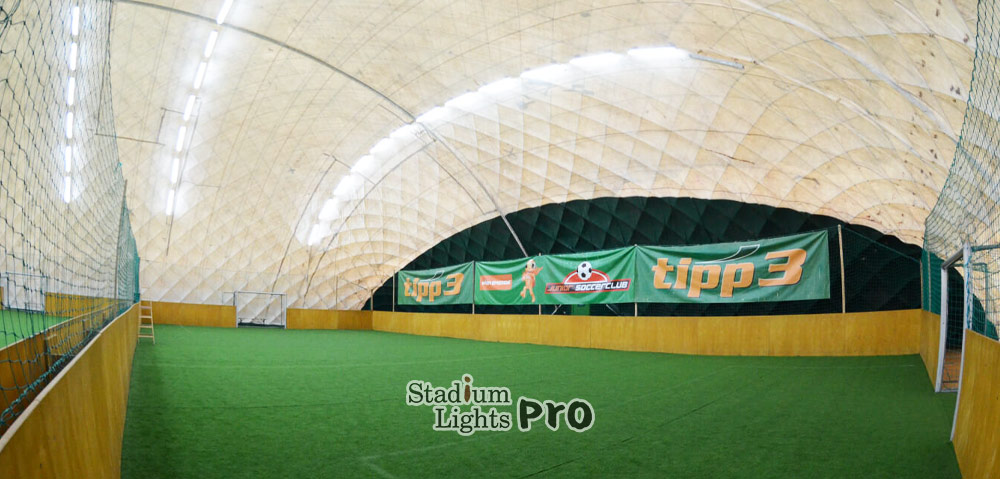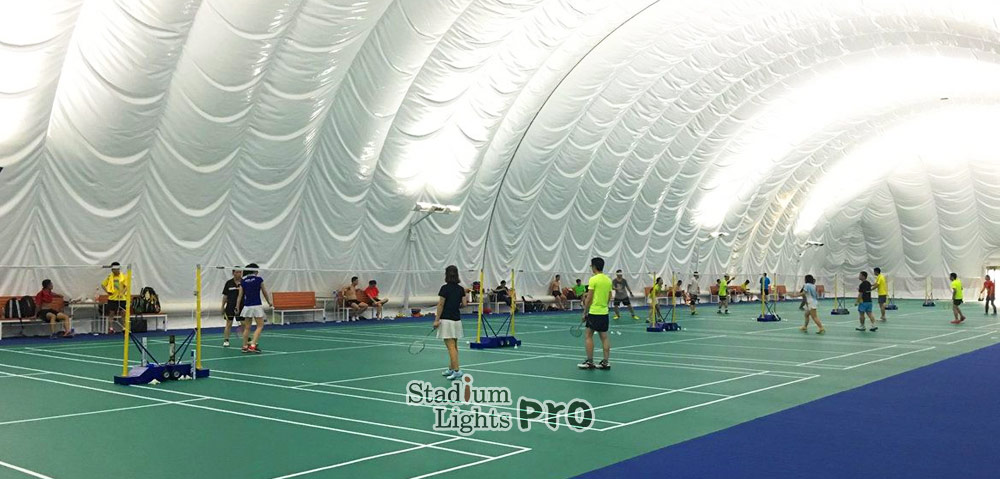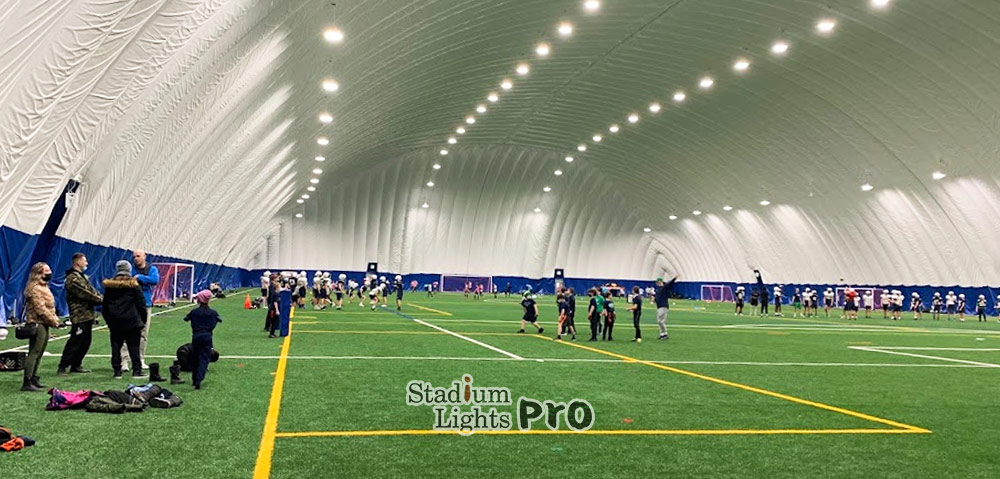Lighting is essential in sports domes for several reasons. First and foremost, it ensures that the players and officials can see the field or court clearly and safely. Adequate lighting also enhances the overall spectator experience by allowing viewers to see the action more clearly.
Besides, lighting design and layout can also have a significant impact on the aesthetics of the dome. Proper lighting can create a more visually appealing and engaging atmosphere for both players and spectators.
The design and layout process for sports dome lighting involves a number of steps. First, the specific requirements of the sport being played in the dome must be taken into account. This includes the minimum lighting levels required for the sport as well as any specific layout or placement requirements.
Next, the size and layout of the dome must be considered. The lighting design must be tailored to the specific dimensions and features of the dome, including the height of the ceiling and the location of any support structures or obstacles.
Table of Contents
ToggleFactors to consider when designing sports dome lighting
Type of sport played in the dome
Different sports have different lighting requirements, so we need to understand the specific needs of the sport in question.
For example, sports that involve a high-speed ball or puck, such as soccer, football, or hockey, may require higher lighting levels in order to ensure that the players and officials can see the ball clearly. This is essential for sports that are played at night or in low light conditions, as the ball or puck can be difficult to see without sufficient lighting. Higher lighting levels may be necessary to ensure that the players can see each other and the field or court clearly, which is essential for their safety and the overall flow of the game.
In contrast, sports that do not involve a high-speed ball, such as basketball or volleyball, may have lower lighting requirements. This is because the ball or object being played with is typically larger and easier to see, so the lighting levels do not need to be as high.
The layout of the lighting may also need to be adjusted based on the sport being played. For example, a sport like basketball may require lighting that is more evenly distributed across the entire court, while a sport like soccer may require more concentrated lighting in certain areas of the field.
Minimum lighting requirements for the sport

Minimum lighting requirements for a sport refer to the minimum level of lighting that is necessary for the sport to be played safely and effectively. These requirements are typically set by the governing bodies or organizations that oversee the sport, and are based on a variety of factors such as the speed of the ball or puck, the size of the playing surface, and the visibility needs of the players and officials.
For example, the minimum lighting requirements for soccer are typically set at around 300 lux (a unit of measure for light intensity). This level of lighting is necessary to ensure that the players can see the ball and each other clearly, and to reduce the risk of injury due to poor visibility.
Other sports may have different minimum lighting requirements. For example, the minimum lighting requirements for basketball are typically lower than those for soccer, as the ball is larger and easier to see. Similarly, sports that are played indoors or in low light conditions, such as ice hockey, may have higher minimum lighting requirements to ensure that the players and officials can see the action clearly.
Size and layout of the dome
The lighting design must be tailored to the specific dimensions and features of the dome, as well as the sport being played.
The size of the dome will affect the number and placement of lights needed to provide adequate lighting. Larger domes will require more lights to cover the entire playing surface, while smaller domes may be able to use fewer lights. The layout of the dome, including the height of the ceiling and the location of any support structures or obstacles, will also impact the lighting design.
We need to carefully plan the placement of the lights to ensure that they provide optimal coverage and visibility. This may involve using a combination of overhead lights, as well as lights placed on poles, trusses, or other supports. The lights should be positioned in a way that minimizes shadows and glare, and provides a consistent level of lighting across the entire playing surface.
The size and layout of the dome may also impact the aesthetics of the lighting design. For example, the height of the ceiling may allow for the use of more dramatic or elaborate lighting setups, such as hanging lights or clusters of lights.
Available budget for lighting
There are a wide range of lighting options available for sports domes, including LED lighting, metal halide lighting, high-pressure sodium lighting, and fluorescent lighting. LED lighting is generally considered to be the most energy-efficient and cost-effective option, but it may also be more expensive upfront compared to other types of lighting. Metal halide and high-pressure sodium lighting are more traditional options that tend to be less expensive, but they may not be as energy-efficient and may require more maintenance. Fluorescent lighting is another option, but it may not provide as much light as other types of lighting and may not be suitable for all sports.
When determining the budget for lighting, it is recommended to consider the long-term costs of the lighting system, including the cost of energy and maintenance. By choosing a lighting system that is energy-efficient and requires minimal maintenance, it may be possible to save money over the long term, even if the upfront cost is higher.
Types of lighting systems for sports domes
LED lighting

LED lighting is a popular choice for sports domes due to its energy-efficiency, long lifespan, and versatility. LED lights use up to 80% less energy than traditional incandescent lights, and they are available in a variety of colors and can be easily controlled and dimmed.
Metal halide lighting
Metal halide lighting is a traditional type of lighting that uses a gas discharge process to produce light. Metal halide lights are typically more affordable than LED lighting, but they are also less energy-efficient and may require more maintenance.
High-pressure sodium lighting
High-pressure sodium lighting is another traditional type of lighting that uses a high-pressure sodium vapor lamp to produce light. Like metal halide lighting, high-pressure sodium lighting is generally less expensive than LED lighting, but it is also less energy-efficient and may require more maintenance.
Fluorescent lighting
Fluorescent lighting is a type of lighting that uses fluorescent lamps to produce light. Fluorescent lighting is generally less expensive than other types of lighting, but it may not provide as much light as other options and may not be suitable for all sports.
Lighting layout in sports domes
Common layouts for sports dome
Grid layout

This layout involves installing the lights in a grid pattern, with rows of lights running parallel to the length of the field and columns of lights running perpendicular to the width of the field. This provides uniform illumination across the entire field, but may not be as energy efficient as other layouts.
Ring layout
It involves installing the lights around the perimeter of the dome, at the top of the dome structure. This provides good illumination for the field, but may not be as effective at illuminating the stands or other areas outside of the field.
Hybrid layout
Hybrid layout combines elements of the grid and ring layouts, by installing some lights in a grid pattern on the field and others around the perimeter of the dome. This can provide a more balanced illumination of the field and surrounding areas.
Pole-mounted layout
The layout involves installing the lights on poles around the perimeter of the field. This can provide good illumination of the field, but may not be as effective at illuminating areas outside of the field.
Placement of lights for optimal coverage and visibility
The lights should be positioned in a way that provides optimal coverage and visibility for the players and officials, as well as for the spectators.
To achieve optimal coverage and visibility, the lights should be placed in a way that minimizes shadows and glare. This may involve using a combination of overhead lights, as well as lights placed on poles, trusses, or other supports. The lights should be positioned in a way that provides a consistent level of lighting across the entire playing surface.
The lights should be arranged in a way that enhances the overall atmosphere of the sports dome, while also taking into account the safety and maintenance needs of the lighting system.
Use of poles, trusses, or other supports to hold lights
Poles, trusses, and other supports can be used to hold lights in sports domes in order to provide optimal coverage and visibility. These supports can be used in combination with overhead lights to create a well-balanced lighting setup that covers the entire playing surface.
Poles are a common type of support used to hold lights in sports domes. These can be placed around the perimeter of the dome or at specific locations on the field or court. The height of the poles and the placement of the lights on the poles will depend on the specific requirements of the sports dome and the sport being played.
Trusses are another type of support that can be used to hold lights in sports domes. Trusses are structures made of interconnected beams that can be used to support lights and other equipment. Trusses can be used to create more elaborate or dramatic lighting setups, and they can be placed at different heights within the dome to provide optimal coverage and visibility.
Other types of supports, such as scaffolding or cables, can also be used to hold lights in sports domes. These supports may be used in combination with poles or trusses, or they may be used on their own to create a specific lighting effect or to cover a particular area of the playing surface.
How many sports dome lights do we need?
The number of lights needed to light a sports dome will depend on a variety of factors, including the size of the dome, the type of sport being played, and the desired lighting levels. Here are some assumptions and calculations to help determine the number of lights needed for a sports dome:
Assumptions:
- The dome has a rectangular shape with a length of 100 meters and a width of 50 meters.
- The ceiling height of the dome is 15 meters.
- The desired lighting level for the sport being played is 300 lux.
Calculations:
- The total area of the playing surface is 100 meters x 50 meters = 5,000 square meters.
- To achieve a lighting level of 300 lux, we will need to provide 300 lumens of light per square meter.
- Therefore, the total number of lumens needed for the playing surface is 5,000 square meters x 300 lumens/square meter = 1,500,000 lumens.
- If we assume that each light provides 50,000 lumens, then we will need 1,500,000 lumens / 50,000 lumens/light = 30 lights.
This is just an example calculation and the actual number of lights needed may be different depending on the specific requirements of the sports dome and the sport being played.
Considerations for safety and maintenance
The lighting system should be designed and installed in a way that minimizes the risk of accidents or injuries, and it should be easy to maintain in order to ensure that it is always in good working order.
Electrical safety
The lighting system should be installed in a way that minimizes the risk of electrical accidents or injuries. This may involve using proper electrical connections, grounding, and protective measures to ensure the safety of the system.
Structural safety
The lighting system should be installed in a way that minimizes the risk of structural failure or collapse. This may involve using strong and reliable supports, such as poles or trusses, to hold the lights, as well as ensuring that the lights are properly secured and balanced.
Maintenance
The lighting system should be designed and installed in a way that makes it easy to maintain. This may involve using lights with a long lifespan, as well as choosing a lighting system that requires minimal maintenance.
Conclusion
The design and layout of the lighting in a sports dome involves a number of factors, including the type of sport being played, the minimum lighting requirements for the sport, the size and layout of the dome, and the available budget for lighting.
There are several types of lighting systems that can be used in sports domes, including LED lighting, metal halide lighting, high-pressure sodium lighting, and fluorescent lighting. The best lighting system for a sports dome will depend on the specific needs and budget of the project.
Looking for a sports dome lighting design? Look no further! We offer free sports dome lighting design services to help you select the best lighting option for your dome at the best price. Our team of lighting experts will work with you to understand the specific needs and budget of your project, and will provide you with a range of lighting options to choose from. Whether you need a functional and energy-efficient lighting system for your sports dome, or a more elaborate and visually striking lighting setup, we have the expertise and experience to help you find the perfect solution. Contact us today to learn more about our sports dome lighting design services and to get started on your project.

